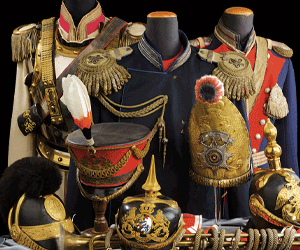Afrikakorps Kriegsmarine White Junior Officer Ranks Visor Cap
SKU: 23.GOR.01.01.02.01.003
Estimated market value:

Estimated market value:
Attributes
History
During the Second World War, German troops stationed in northern Africa are generally referred to as the Afrikakorps. Technically, this is not entirely correct, since some German units operating in Africa were not actually part of the DAK (Deutsches Afrikakorps), and some units of it were, in fact, Italian ones. However, for the purpose of collecting so-called “tropical” uniforms and insignia, collectors have simplified the meaning of the term.
The first German troops were sent to northern Africa in February of 1941, to support their Italian allies against the British. The climate of the African continent made it necessary to wear specialised uniforms and gear that not only supported the soldiers in serving in a hot and arid environment, but also helped them in blending in with the landscape, which, in general, presented itself as brown, olive, khaki, or sand/tan in colour. Worn over long periods of time under the blistering desert sun, some uniforms were eventually bleached to white or off-white. Uniforms and insignia in these colours are often referred to as “tropical”, and it is worth noting that they weren’t just worn by members of units stationed in Africa, but in the entire Mediterranean theatre of war, including southern France, Italy, the Balkans, and Greece, as well as in southern Russia during the summer months. Tropical uniforms were worn by members of all three branches of the Wehrmacht: the Heer (army), the Kriegsmarine (navy), and the Luftwaffe (air force). Members of the Waffen-SS stationed in southerly regions also wore tropical-style uniforms, and even though they technically have no connection to the DAK, all tropical uniforms and insignia of all branches of the German military are listed here.
This White Visor Cap was worn as part of the white summer/tropical uniform by Officers and Non-Commissioned Officers of the Kriegsmarine, it was not worn by enlisted personnel.
The cap is composed of several main elements, including the cloth top cover and piping, the cap band with piping, the visor with associated visor trim, and the chin strap/cord. In the cap interior, the main elements include the top metal stiffener (removable), the inside lining, the diamond-shaped moisture shield (not always present), the sweat band, and the manufacturer's logo and associated information. Each cap was also adorned with an oak leaf wreath and cockade in the centre of the cap band, and a national emblem above the cap band and along the front seam of the cap.
The cap features a removable white top cover and an additional layer of white gauze on top of the cloth lining. It was made from high-quality cotton fabrics, such as moleskin.
The cap band is composed of hardened, ribbed black mohair, which was hardened through the addition of other materials, such as plastic or pasteboard.
The earliest caps feature visors composed of black lacquered “Vulkanfiber” that are trimmed in leather piqué. There are also examples of caps with visors made from natural leather and a leather piqué trim. From 1936 onwards all visors were decorated with additional features that reflected the wearer’s rank group, including cords of oak leaves or scalloping. These features were initially made of bullion wire or celleon, and later from stamped metal that was made to look like embroidery. The caps of Administrative Officials, Non-Commissioned Officers, and Officer Candidates were exempt from the 1936 changes, and their cap visors remained black and lacked the cloth covering and rank features.
The visor caps of Junior Officers, with the rank of Ensign (Leutnant zur See) through to Lieutenant (Kapitänleutnant) and Music Officer (Stabsmusikmeister) feature a single row of gold-coloured scalloping along the visor’s border.
The visor caps of Senior Officers below the rank of Admiral, including Stabsoffiziere, Musikinspizienten, and Korvettenkapitän through to Kommodore, feature a single row of interlocking gold-coloured oak leaves, embroidered in bullion or celleon, along with the visor’s border.
The visor caps of Admirals feature two rows of interlocking gold-coloured oak leaves, embroidered in bullion or celleon, which originate from the same stem and meet along the centre along the visor’s border.
The chin strap for Officers and Senior Non-Commissioned Officers is composed of black patent, lacquered, simulated, or matte leather.
The inside lining of the caps is generally made from rayon. The rayon lining ranges from gold to white.
The sweatband is predominantly composed of genuine leather and was rarely made from artificial leather. The most frequently encountered sweatband colours are tan, dark and reddish brown, and gray.
The moisture shield is made of transparent celluloid.
While Kriegsmarine caps generally lack manufacturer logos, when present they were placed on or under the moisture shield; one well-known manufacturer is Steinmetz & Hehl, Hamburg. The logo tended to be accompanied by the year of production and the size of the cap.
On all Officer visor caps, the insignia are gold-coloured and may be composed of stamped metal made to look like embroidery, hand-embroidered bullion wire, or machine woven and embroidered celleon, cotton, or artificial silk thread. The insignia were silver-coloured for Administrative Officials with the rank of Officer. Generally, the insignia worn on the visor caps of Officers were of a higher quality of manufacture and material than those worn on the caps of Non-Commissioned Officers.
For Administrative Officials (Wehrmachtbeamte der Marine), the caps have a twisted, silver-coloured chin cord, made from silver wire or aluminum. The caps of Officials who held a rank up to Kapitän zur See feature silver wire or aluminum cords, while those with the rank of Admiral feature gold-coloured cords.
The Visor Cap may also be known as the Peaked Cap or Service Cap.


Comments
Sign in to comment and reply.


Scroll Top